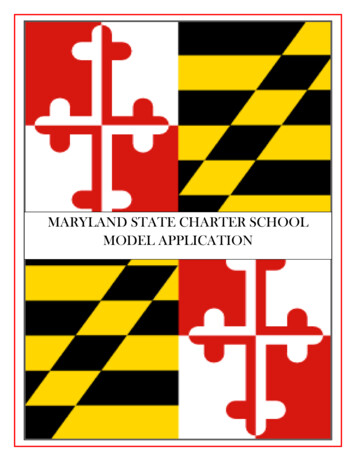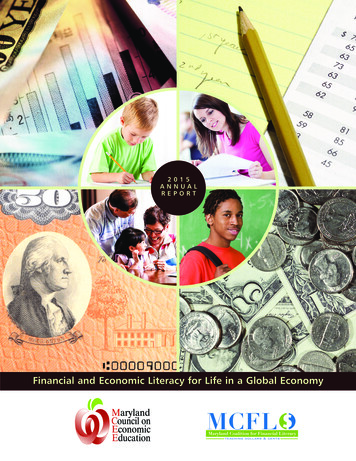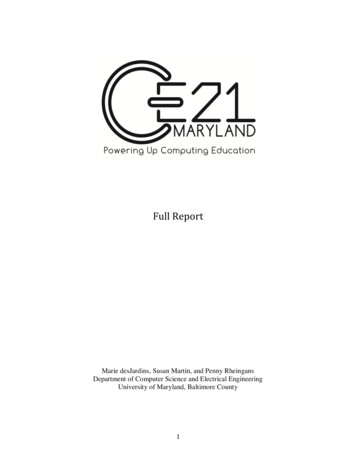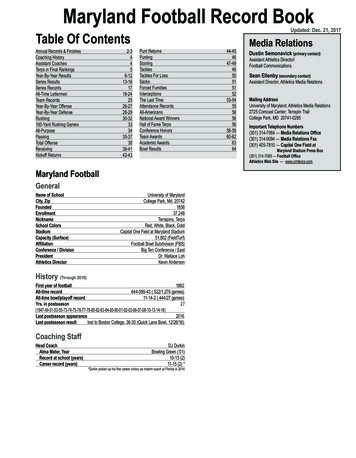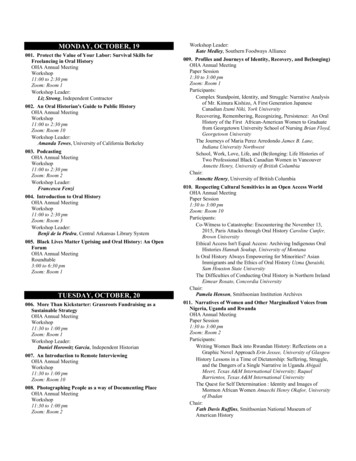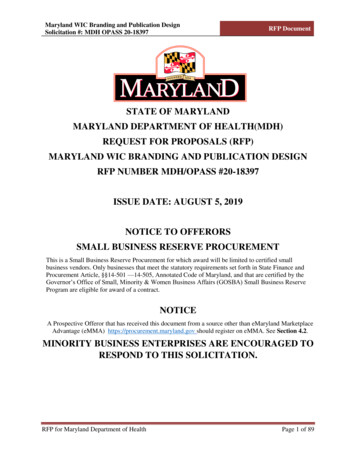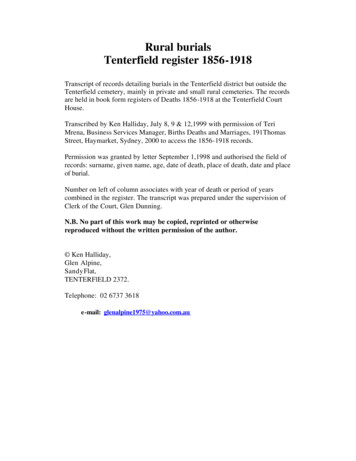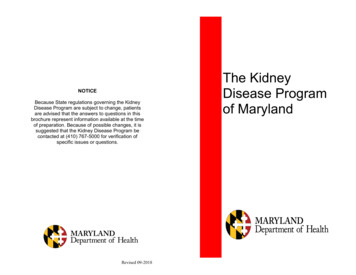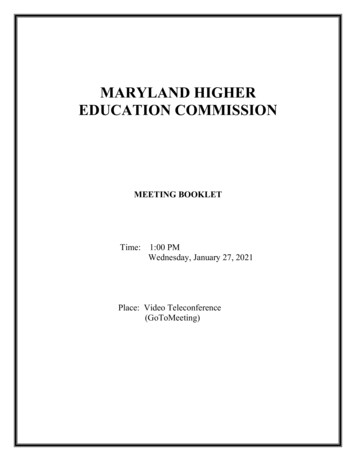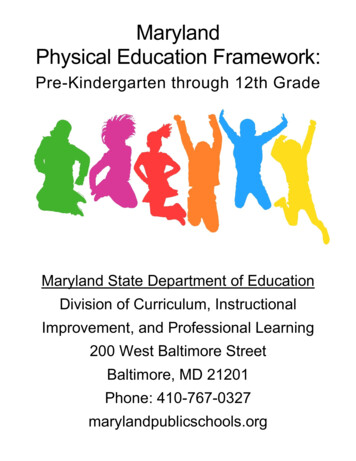
Transcription
MarylandPhysical Education Framework:Pre-Kindergarten through 12th GradeMaryland State Department of EducationDivision of Curriculum, InstructionalImprovement, and Professional Learning200 West Baltimore StreetBaltimore, MD 21201Phone: 410-767-0327marylandpublicschools.org
State Board of EducationBrigadier General Warner I. Sumpter, USA, Ret., PresidentJean C. Halle, Vice PresidentGail H. BatesClarence C. CrawfordCharles R. Dashiell, Jr., Esq.Vermelle Greene, Ph.D.Justin M. Hartings, Ph.D.Dr. Joan Mele-McCarthy, D.A., CCC-SLPRose Maria Li, MBA, Ph.D.Rachel L. McCuskerLori MorrowDavid M. Steiner, Ph.D.Michael PhillipsNoureen A. BadwiKaren B. Salmon, Ph.D.State Superintendent of SchoolsSecretary-Treasurer of the BoardLarry HoganGovernorMaryland State Department of EducationCarol A. Williamson, Ed.D., Deputy State SuperintendentMarcia A Sprankle, Ed.D., Assistant State SuperintendentSusan Spinnato, Director of Instructional ProgramsJason Semanoff, Physical Education Program SpecialistLea Jaspers, Health Education Program SpecialistDouglas Robertson, Management AssociateBrandon Reisett, Technology Accessibility SpecialistNon-Discrimination StatementThe Maryland State Department of Education does not discriminate on the basis of age,ancestry/national origin, color, disability, gender identity/expression, marital status, race, religion, sex,or sexual orientation in matters affecting employment or in providing access to programs andactivities and provides equal access to the Boy Scouts and other designated youth groups.Equity Assurance & Compliance OfficeMaryland State Department of Education200 West Baltimore Street, Baltimore, MD 21201-2595Voice: 410-767-0426 Fax: 410-767-0431 TTY/TDD: 410-333-6442Maryland Physical Education Framework: Pre-Kindergarten through 12th Grade May 2020-2-
Table of ContentsAcknowledgements: .4Mission Statement: .5Maryland Physical Education Content Standards PK-12: .5About This Resource: .5Identifiers: .6Assessments: .6Additional Resources:.6Glossary: .7Elementary – Primary Grades . 11Standard 1 – Motor skills and movement patterns. 11Standard 2 – Concepts and strategies . 13Standard 3 – Health-enhancing level of physical activity and fitness . 14Standard 4 – Responsible personal and social behavior . 14Standard 5 – Recognizes the value of physical activity. 15Elementary – Intermediate Grades . 17Standard 1 – Motor skills and movement patterns . 17Standard 2 – Concepts and strategies . 21Standard 3 – Health-enhancing level of physical activity and fitness . 22Standard 4 – Responsible personal and social behavior . 23Standard 5 – Recognizes the value of physical activity. 23Middle School . 25Standard 1 – Motor skills and movement patterns . 25Standard 2 – Concepts and strategies . 27Standard 3 – Health-enhancing level of physical activity and fitness . 28Standard 4 – Responsible personal and social behavior . 28Standard 5 – Recognizes the value of physical activity. 29High School. 31Standard 1 – Motor skills and movement patterns . 31Standard 2 – Concepts and strategies . 31Standard 3 – Health-enhancing level of physical activity and fitness . 31Standard 4 – Responsible personal and social behavior . 32Standard 5 – Recognizes the value of physical activity. 32Maryland Physical Education Framework: Pre-Kindergarten through 12th Grade May 2020-3-
Acknowledgements:This update of the Maryland Physical Education Framework: Pre-Kindergarten through 12th Gradedocument would not have been possible without the efforts of many people. Members of theworkgroup gave much of their time and expertise in developing the grade-level outcomes. Theworkgroup members are:Dr. James Barry, Assistant ProfessorPETE ProgramSalisbury UniversityDeborah Basler, Supervisor of High SchoolHealth, Physical Education, and AthleticsHarford County Public SchoolsDr. Nicole Bosley, Assistant ProfessorHealth and Physical Education ProgramFrostburg State UniversityAmy Falls, Resource TeacherElementary Physical EducationAnne Arundel County Public SchoolsCaitlin Fregelette, TeacherPhysical EducationCalvert County Public SchoolsDr. Rebecca Gallagher, Assistant ProfessorHealth and Physical Education ProgramFrostburg State UniversityJohn Stuart Gordon, StudentPhysical Education MCERT ProgramUniversity of Maryland – College ParkDr. Cara Grant, Supervisor of PreK-12Adapted PE, Health, and Physical EducationMontgomery County Public SchoolsBrian Griffith, Curriculum SpecialistSecondary Health and Physical EducationFredrick County Public SchoolsJoseph Harbert, Supervisor of Elementary &Middle School Health & Physical EducationHarford County Public SchoolsJames Hitchner, Curriculum SpecialistElementary Health and Physical EducationFredrick County Public SchoolsBrad Hunter, TeacherPhysical EducationBaltimore City Public SchoolsKaren Kart, Content Specialist PreK-12Adapted Physical EducationMontgomery County Public SchoolsBill Keswick, Supervisor of Science, PE,Health, and Community Wellness ProgramsTalbot County Public SchoolsNicholas Klug, Resource TeacherSecondary Physical EducationAnne Arundel County Public SchoolsDr. Dillon Landi, Assistant ProfessorDepartment of KinesiologyTowson UniversityGeoffrey Meehle, Coordinator ofHealth and Physical EducationBaltimore City Public SchoolsEric Michael, Supervisor of AthleticsHealth, and Physical EducationWashington County Public SchoolsTyrone Mills, Coordinator of Health,Physical Education, and AthleticsWorcester County Public SchoolsJustin O’Brien, SupervisorPhysical EducationBaltimore County Public SchoolsMichael Page, Supervisor ofInstructionQueen Anne’s County Public SchoolsMichelle Proser, Coordinator ofHealth and Physical EducationBaltimore County Public SchoolsJim Rodriguez, Supervisor ofHealth and Physical EducationCarroll County Public SchoolsBritta Sparks, Supervisor ofHealth and Physical EducationCalvert County Public SchoolsNick Thompson, Supervisor of PE, Health,and Family & Consumer SciencesWicomico County Public SchoolsDr. Tab Uhrich, DirectorAcademic AssessmentTowson UniversityChristiana Walsh, Coordinator ofHealth, Physical Education, and DanceAnne Arundel County Public SchoolsMichael Watson, Director ofFacilities, Health, PE, and AthleticsSt. Mary’s County Public SchoolMaryland Physical Education Framework: Pre-Kindergarten through 12th Grade May 2020-4-
Mission Statement:The goal of Physical Education is to develop physically literate individuals who have the knowledge,skills, and confidence to enjoy a lifetime of healthful physical activity. To pursue a lifetime of healthfulphysical activity, a physically literate individual: Has learned the skills necessary to participate in a variety of physical activities,Knows the implications and the benefits of involvement in various types of physical activities,Participates regularly in physical activity,Is physically fit,And values physical activity and its contributions to a healthful lifestyle.— National Standards and Grade-Level Outcomes for K-12 Physical Education (2014), SHAPEAmerica.Maryland Physical Education ContentStandards PK-12:Students shall:(1) Demonstrate competency in a variety of motor skills and movement patterns;(2) Apply knowledge of concepts, principles, strategies, and tactics related to movement andperformance;(3) Demonstrate the knowledge and skills to achieve and maintain a health-enhancing level ofphysical activity and fitness;(4) Exhibit responsible personal and social behavior that respects self and others; and(5) Recognize the value of physical activity for health, enjoyment, challenge, self-expression, andsocial interaction. COMAR 13A.04.13.01CAbout This Resource:This document is designed to identify what students should know and be able to do by the end ofeach grade. The framework is not a Physical Education curriculum. The local school systems (LSSs)must use this document as a guide in developing their own curriculum and other instructionalresources.Teachers should use these grade-level outcomes to make instruction-related decisions and to createmeaningful assessments that measure student achievement in all areas of Physical Educationinstruction.If an outcome is not identified for a particular grade level then it is not a pedagogically appropriateskill to teach at that time. If an LSS has access to other facilities at its disposal, they can createadditional outcomes that meet the needs of their students. For example, if a school system hasaccess to a pool, they can create outcomes based on water safety and aquatics.It is highly recommended that LSSs identify the critical elements necessary for their students toperform a skill with a mature pattern. The LSSs should also define how many critical elements and/orwhich critical elements are needed for a mature pattern when designing an assessment. Futureversions of this document will provide further guidance on identifying the critical elements of eachfundamental skill and how they can be used for both formative and summative assessments.Maryland Physical Education Framework: Pre-Kindergarten through 12th Grade May 2020-5-
Identifiers:Assessments:The Maryland State Department of Education (MSDE) recognizes that grading policies are developedby each Local School System (LSS). Those policies must incorporate standards-based instructionalassessments that:a) Periodically evaluate progress toward achievement of the Maryland Physical EducationContent Standards;b) Align to the Grade-Level Outcomes of the Maryland Physical Education Framework;c) Monitor a student’s cognitive, affective, and psychomotor progress;d) Include all students;e) Do not evaluate student dress or attendance; andf) Are not based on the results of a health-related fitness test.LSSs may conduct a health-related fitness assessment as part of an annual Wellness PolicyImplementation and Monitoring Plan to establish baseline student data for the health-relatedcomponents of physical fitness as defined in Education Article §7–409, Annotated Code of Maryland.Additional Resources:Maryland State Department of Education – marylandpublicschools.orgMaryland Learning Links - marylandlearninglinks.orgSociety of Health and Physical Educators of Maryland - shapemd.orgMaryland’s Adapted Physical Education Consortium - bit.ly/MDAPECSociety of Health and Physical Educators of America - shapeamerica.orgCenters for Disease Control and Prevention – cdc.gov/healthyschoolsNational Consortium for Physical Education for Individuals with Disabilities – ncpeid.orgMaryland Physical Education Framework: Pre-Kindergarten through 12th Grade May 2020-6-
Glossary:Accuracy – Eighty percent or above successful performance of a task. Scores in the range of sixty toseventy-nine percent are considered to be reasonably accurate.Adapted Physical Education – A specifically designed Physical Education service where theprogram is adapted to meet the needs of each student through modifications and accommodations inthe least restrictive environment. A Guide for Serving Students with Disabilities in Physical Education(pdf)Aerobic Capacity/Cardiovascular Endurance – The body’s ability to use oxygen to create energy.Many factors influence aerobic fitness, including lung efficiency, cardiac function, age, and geneticmakeup.Affective Domain – The domain of learning which focuses on personal-social development,attitudes, values, feelings, motivations, emotions, and social skills needed to work cooperatively withothers.Cardiorespiratory Endurance – The ability to sustain exercise that increases heart rate andbreathing rate. Examples might include running, cycling, swimming, and cross-country skiing.Challenge – An essential factor for effective lesson design and goal-setting that leverages students’previous knowledge and skills to advance their lifelong learning through assertiveness, responsibility,and perseverance. To foster challenging learning experiences, struggle and progress go hand inhand to achieve incremental mastery of complex competences.Cognitive Domain – The domain of learning which focuses on knowledge and intellectualunderstanding of content.Critical Elements – The key components of a motor skill that can be observed, the sum of whichresults in movement efficiency.Cues – Short, student-friendly phrases that provide key points to a skill.Culturally Relevant Teaching – The deliberate and strategic implementation of a lesson plan thatrecognizes the importance of including students’ backgrounds, interests, skill levels, and learningstyles.Differentiated Instruction – A method of instruction in which teachers actively plan and varyteaching strategies to accommodate individual differences based on students’ backgrounds, interests,skill levels, and learning styles.Distance – Space (length, width, or height) that is constantly adjusted to be developmentallyappropriate and meet individual needs while still challenging students to perform a skill and meet thesafety requirements/limitations of the instructional space.Dynamic Environment (Open Skills) – Skills performed in an unpredictable way, while in motion.Elements of Dance – Movement, relationship, time, energy, space, and body.Endurance – The ability to perform an exercise for an extended period of time.Exergaming – Video games that require physical activity during play.Feedback – Statements that inform the student of their strengths and areas for improvement.Corrective statements should be given in a timely manner and be individualized, positive, and skillspecific with the goal of enhancing performance. Examples might include cross-space, oral, written,peer-to-peer, and one-on-one.Fitness Activities – Activities that focus on improving or maintaining health-related fitness. Examplesmight include yoga, resistance training, spinning, running, fitness walking, fitness swimming,kickboxing, cardio-kick, and exergaming.Formal Assessments – Evaluating student performance with a written or standardized instrumentthat may have a predetermined criterion.Formative Assessments – Assessments that are ongoing during instruction, allowing teachers totrack student progress and adapt instruction accordingly.Maryland Physical Education Framework: Pre-Kindergarten through 12th Grade May 2020-7-
Glossary (continued):Fundamental Motor Skill – Locomotor, non-locomotor, and manipulative skills that provide thefoundation for more complex movement patterns used in games and sports.Grade-Level-Outcomes (GLOs) – Evidence-based, deliberate, and strategic progressions thatclarify what students should know and be able to do at various points in their PreK-12 academiccareer.Health-Related Fitness Components – Aerobic capacity, body composition, flexibility, muscularstrength, and muscular endurance.Health-Related Fitness Assessment – Assesses the health-related fitness components of aerobiccapacity, body composition, flexibility, muscular endurance, and muscular strength. Teachers mustencourage personal fitness improvement, personal bests, and personal skill achievement. Studentswho receive negative feedback based on fitness scores most often develop negative attitudes towardphysical activity, which goes against the goal of Physical Education. Health-Related Fitness Testingin Maryland (pdf)High School Level 1 – The Maryland State Department of Education required 0.5 credit course anda prerequisite to High School Level 2 courses. These outcomes reflect the minimum knowledge andskills that students must acquire and attain by graduation to be college or career-ready.High School Level 2 – Outcomes that build on Level 1 competencies by augmenting knowledge andskills considered desirable for college or career readiness.Inclusion – The provision of a learning environment where students with disabilities haveopportunities to participate and learn with their nondisabled peers in a general education setting.Individual-Performance Activities – Activities that allow an individual to pursue lifelong fitnesswithout the need of teammates. Activities might include gymnastics, figure skating, track and field,multisport events, in-line skating, wrestling, self-defense, and skateboarding.Informal Assessment – Assessment that evaluates student performance without a formal or writteninstrument to inform instruction.Invasion Games – Activities in which students try to advance into an opponent’s territory in order toscore a goal or point. Maintaining possession, offensive and defensive tactics, and communicationare crucial to success. Activities might include soccer, basketball, hockey, ultimate, and handball.Lifetime Activities – Activities that are suitable for participation across the lifespan and that one canundertake alone or with a partner as opposed to a team. Examples might include outdoor pursuits,individual-performance activities, aquatics, net/wall games, and target games.Least Restrictive Environment (LRE) – An environment in which supplementary aids, services,supports, and program modifications are provided to students with disabilities to access the standardsbased curriculum.Mature Pattern – A pattern in which students execute with efficiency all of the critical elements of amotor skill in an authentic environment.Moderate-to-Vigorous Physical Activity (MVPA) – Activities that are equivalent to the intensity of abrisk walk, bicycling, jogging, or aerobic dancing that cause an increase in breathing and heart rate.Modified Games – Small-sided games in which the rules have been changed to deliberatelyemphasize and provide additional practice of particular skills and tactics taught in class.Movement Concepts – Applicable principles and knowledge related to skillful performance ofmovement and fitness activities, such as spatial awareness, effort, tactics, and strategies related tomovement efficiency and health-enhancing fitness.Newton’s Three Laws of Motion – The movement concepts of the Law of Inertia, the Law of Motion,and the Law of Action and Reaction, which can be applied to various outcomes.Maryland Physical Education Framework: Pre-Kindergarten through 12th Grade May 2020-8-
Glossary (continued):Non-Dynamic Environment (Closed Skills) – Skills that are performed in a constant, predictable, orstationary way. The goal for performers is to produce movements that are consistent and accuratebecause the environment is stable and unchanging.Nutrient-Dense Foods – Foods that provide vitamins, minerals, and other substances with little or nosolid fats, added sugars, refined starches, and sodium. The “all foods fit” philosophy must beemphasized where there are no “good” foods or “bad” foods and all foods provide nourishmentwhether physical or emotional. The idea that no food has moral value is an important concept inremoving judgments and distortions that often form in disordered eating.Outcomes – Statements that specify what learners will know or be able to do as a result of a lesson.Outdoor Pursuits – Activities might include kayaking, canoeing, sailing, rowing, hiking, backpacking,fishing, orienteering, geocaching, ice skating, skateboarding, snow skiing, water skiing,snowboarding, snowshoeing, surfing, bouldering, traversing, climbing, mountain biking, adventureactivities, and ropes courses. Selection of activities is dependent on the environmental opportunitieswithin the geographical region.Overload Principle – The principle that it is necessary to place increasing demands on the bodyduring exercise to cause the body to adapt. This is accomplished by manipulating the frequency,intensity, time (duration), and type (FITT) of activity.Psychomotor Domain – The domain of learning which focuses on the performance of motor skills.Rubric – An assessment and instructional tool that identifies criterion behaviors for at least two levelsof performance. Each level of the rubric identifies and describes criterion behaviors that containcritical elements of the tasks along a range or continuum of performance expectations.Skill Proficiency Continuum – The three stages of skill development and application:Emerging – Showing some skill development through practice in a non-dynamic environment.Maturing – Demonstrating most of the critical elements through practice.Applying – Demonstrating a mature pattern in a dynamic environment.Skill-Related Fitness Components – Speed, power, agility, balance, coordination, and reactiontime.Small-Sided Games – Organized games in which the number of players involved is reduced from theconventional competitive version of the sport.Strategy – The overall game plan that can lead to success.Summative Assessment – An assessment that occurs at the close of a unit, providing teachers witha comprehensive summary of student progress and growth.Tactics – Moment to moment adaptations made to address challenges that arise during game play.Target Games – Activities in which students send (propel) an object toward a target. Control,accuracy, and exhibiting a limited amount of force are crucial to success but not indicative of a maturepattern. Activities might include archery, bocce, bowling, cornhole, croquet, disk golf, golf,horseshoes, ladder ball, and shuffleboard.Task Progression – Building gradually from one activity or task to the next to increase the challengeand complexity of the content.Teaching with Fidelity – Implementing a curriculum the way it was intended to be implemented bythe developers. The program’s critical features are present and delivered as prescribed, and theteachers are supportive and prepared. Physical Education in Maryland (pdf)Technology – Software, websites, devices, and applications used as tools in Physical Education toenhance teaching and learning, not to drive instruction. A technology tool should not become adistraction or a hindrance to moderate-to-vigorous physical activity.Maryland Physical Education Framework: Pre-Kindergarten through 12th Grade May 2020-9-
Maryland Physical Education Framework: Pre-Kindergarten through 12th Grade May 2020- 10 -
Elementary – Primary GradesStandard 1 – Motor skills and movement patternsSkill/ConceptHopping, Galloping,Jogging, Running,Sliding, and SkippingJogging for DistanceJogging for DistancePre-KindergartenMoves using a varietyof locomotor skills.S1.PK.1KindergartenPerforms locomotorskills with balance.S1.K.1Grade 1Demonstrates hopping,galloping, jogging,running, and slidingusing a mature pattern.S1.G1.1This skill becomes aThis skill becomes aThis skill becomes opriate practiceappropriate practiceappropriate practicebeginning in 2nd grade. beginning in 2nd grade. beginning in 2nd grade.BlankBlankblankJumping and LandingDemonstrates a vertical Performs horizontaljump and landing with and vertical jumpingbalance. S1.PK.3and landing actionswith balance. S1.GK.3Demonstrates somecritical elements forjumping and landing ina horizontal planeusing two-foot takeoffsand landings. S1.G1.3aJumping and LandingBlankBlankDancePerforms creativemovements to therhythm of music.S1.PK.4Performs locomotorskills in response toteacher-led creativedance. S1.GK.4BalanceIdentifies differentbases of support.S1.PK.5aMaintains balance ondifferent bases ofsupport. S1.GK.5aBalanceBalances on differentbody parts. S1.PK.5bDemonstrates somecritical elements forjumping and landing ina vertical plane.S1.G1.3bCombines locomotorand non-locomotorskills in a teacherdesigned dance.S1.G1.4Maintains balance ondifferent bases ofsupport with differentbody shapes. S1.G1.5blankWeight TransferForms wide, narrow,curled, and twistedbody shapes.S1.GK.5bThis skill becomes aThis skill becomes adevelopmentallydevelopmentallyappropriate practiceappropriate practicebeginning in 1st grade. beginning in 1st grade.Weight Transfer RollingCreates curled shapes Demonstrates rollingwith their body.sideways in a narrowS1.PK.7abody shape. S1.GK.7Weight Transfer RollingDemonstrates how torock on different bodyparts. S1.PK.7bBlankTransfers weight fromone body part toanother in personalspace in dance andgymnasticsenvironments. S1.G1.6Demonstrates rollingwith either a narrow ora curled body shape.S1.G1.7blankGrade 2Demonstrates skippingusing a mature pattern.S1.G2.1Demonstrates joggingfor distance with amature pattern.S1.G2.2aTravels showingdifferentiation betweenjogging and sprinting.S1.G2.2bDemonstrates mostcritical elements forjumping and landing ina horizontal planeusing a variety of oneand two-foot takeoffsand landings. S1.G2.3aDemonstrates mostcritical elements forjumping and landing ina vertical plane.S1.G2.3bPerforms a rhythmicactivity with correctresponse to simplerhythms. S1.G2.4Balances on differentbases of support,combining levels andshapes. S1.G2.5aBalances in an invertedposition with stillnessand supportive base.S1.G2.5bTransfers weight fromfeet to different bodyparts/bases of supportfor balance. S1.G2.6Demonstrates rolling indifferent directions witheither a narrow or acurled body shape.S1.G2.7BlankMaryland Physical Education Framework: Pre-Kindergarten through 12th Grade May 2020- 11 -
Skill/ConceptPre-KindergartenKindergartenGrade 1Curling, Stretching,Stretches the muscles. Contrasts the actions of Demonstrates twisting,Twisting, and Bending S1.PK.8curling and stretching. curling, bending, andS1.GK.8stretching actions.S1.G1.8Combinations This skill becomes aThis skill becomes aThis skill becomes aBalance and yTransfersappropriate practiceappropriate practiceappropriate practicebeginning in 2nd grade. beginning in 2nd grade. beginning in 2nd grade.Rolling a BallRolls a ball to aRolls a ball with theRolls a ball whilestationary partner oropposite foot forward. demonstrating sometarget while seated.S1.GK.10critical elements.S1.PK.10S1.G1.10Underhand ThrowUnderhand throws to a Demonstrates anDemonstrates anlarge, stationary target. underhand throw with underhand throw usingS1.PK.11the opposite footsome critical elements.forward. S1.GK.11S1.G1.11Overhand ThrowThis skill becomes aThis skill becomes aThis skill becomes opriate practiceappropriate practiceappropriate practicebeginning in 2nd grade. beginning in 2nd grade. beginning in 2nd grade.CatchingDemonstrates some of Drops a ball andCatches a soft objectthe critical elementscatches it before itfrom a self-toss beforewhen catching a rolling bounces twice.it bounces. S1.G1.13aball. S1.PK.13S1.GK.13aCatchingBlankCatches a large balltossed by a skilledthrower. S1.GK.13bDribbling with HandsBounces a ball downwith two hands andattempts to catch itwhile remaining inpersonal space.S1.PK.14BlankDribbles a ball with 1hand, attempting thesecond contact.S1.GK.14Catches a variety ofobjects tossed by askilled thrower.S1.G1.13bDribbles continuouslyin personal space usingthe preferred hand.S1.G1.14BlankblankTaps a stationary ballusing the inside of thefoot, maintaining bodycontrol. S1.PK.15Kicks a stationary ballfrom a stationaryposition, maintainingbody control. S1.PK.16Taps a ball using theinside of the foot,sending it forward.S1.GK.15Kicks a stationary ballfrom a stationaryposition, demonstratingsome critical elements.S1.GK.16Underhand VolleyVolleys a lightweightobject using differentbody parts. S1.PK.17Volleys a lightweightobject, sending itupward. S1.GK.17Taps or dribbles a ballusing the inside of thefoot walking in generalspace. S1.G1.15Approaches astationary ball andkicks it forward,demonstrating some ofthe critical elements.S1.G1.16Volleys an object withan open palm, sendingit upward. S1.G1.17Striki
Frostburg State University John Stuart Gordon, Student Physical Education MCERT Program University of Maryland - College Park Dr. Cara Grant, Supervisor of PreK-12 Adapted PE, Health, and Physical Education Montgomery County Public Schools Brian Griffith, Curriculum Specialist Secondary Health and Physical Education Fredrick County Public Schools
